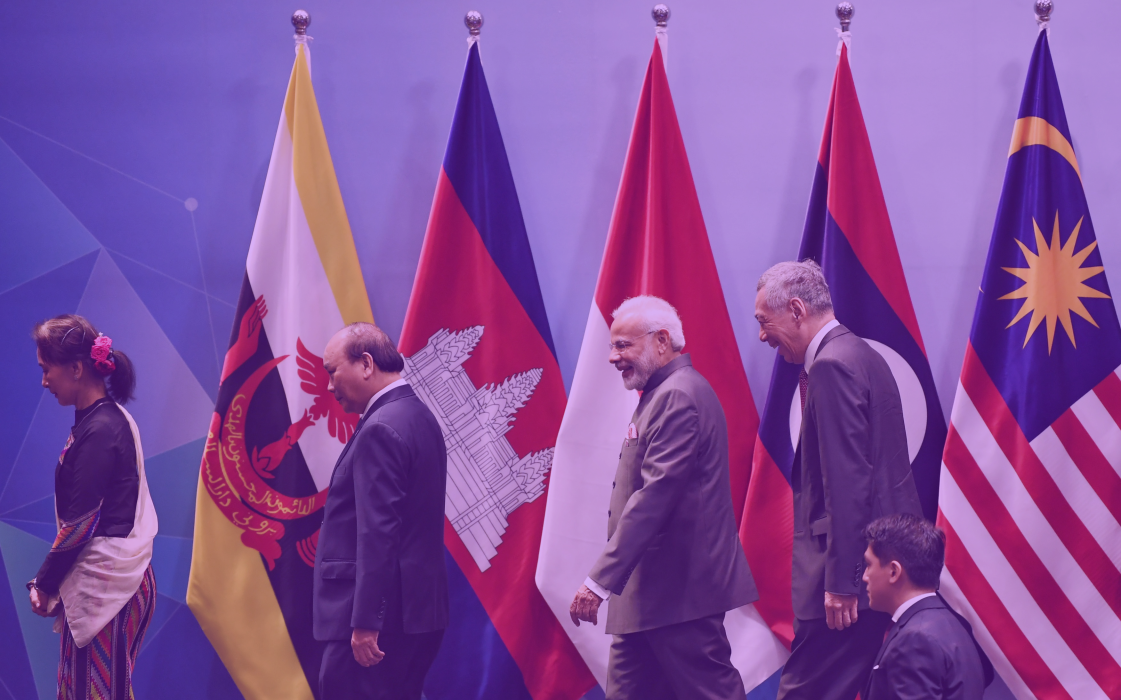Photo: “The Prime Minister, Shri Narendra Modi attending the ASEAN-India Informal Breakfast Summit, in Singapore on November 15, 2018“, by The Government of India, licensed under GODL-India. Hue modified from the original
Lee, Sook Jong, Chin-en Wu, and Kaustuv Kanti Bandyopadhyay. “Introduction: Populism in Asian Democracies.” In Populism in Asian Democracies, pp. 1-18. Brill, 2020.
Description
Populism is a contested concept when applied to Asia. In Populism in Asian Democracies: Features, Structures and Impacts, members of the Asia Democracy Research Network (ADRN) discuss the diverse subtypes of populism in 11 countries across Asia, their structural elements and societal impacts.
Populism takes on different forms in Asia according to its target, rhetoric and strategy. Redistributive populism stems from income inequality and rural poverty while ethno-religious populism represents a continued struggle between majority and minority groups. Progressive populism emphasizes democratic governance over corruption and factional politics, and authoritarian populism rises from government incompetence. As ADRN shows, the 11 Asian democracies have adopted various subtypes—and hybrids—of such populism models, adding importance to regional cooperation in safeguarding democracy.
Table of contents
- Introduction: Populism in Asian Democracies
Sook Jong Lee, Chin-en Wu, and Kaustuv Kanti Bandyopadhyay - Part 1 Progressive Populism
- Chapter 1 South Korea’s Tamed Populism: Popular Protests from Below and Populist Politics from the Top
Sook Jong Lee - Chapter 2 Populism in Taiwan: A Bottom-Up Model
Chin-en Wu and Yun-han Chu
- Chapter 1 South Korea’s Tamed Populism: Popular Protests from Below and Populist Politics from the Top
- Part 2 Authoritarian Populism
- Chapter 3 Contemporary Populism and Democratic Challenges in the Philippines
Francisco A. Magno - Chapter 4 Judicial Populism and Its Impact on the Quality of Democracy in Pakistan
Aasiya Riaz
- Chapter 3 Contemporary Populism and Democratic Challenges in the Philippines
- Part 3 Redistributive Populism
- Chapter 5 Populism in Contemporary Indian Politics
Kaustuv Chakrabarti and Kaustuv Kanti Bandyopadhyay - Chapter 6 Populism in Thailand
Thawilwadee Bureekul, Ratchawadee Sangmahamad, and Nuchaprapar Moksart - Chapter 7 Populism as a Phenomenon: Signs of Populism in Mongolian Development
Gerelt-Od Erdenebileg, Ariunbold Tsetsenkhuu, and Ganbat Damba - Chapter 8 The Changing Nature of Populism in Malaysia
Faiz Abdul Halim and Aira Azhari
- Chapter 5 Populism in Contemporary Indian Politics
- Part 4 Ethnic and Religious Populism
- Chapter 9 Populism in Indonesia: Learning from the 212 Movement in Response to the Blasphemy Case against Ahok in Jakarta
Sri Nuryanti - Chapter 10 Hegemonic Populism: Sinhalese Buddhist Nationalist Populism in Contemporary Sri Lanka
Pasan Jayasinghe - Chapter 11 Populism in Myanmar
Myat Thu
- Chapter 9 Populism in Indonesia: Learning from the 212 Movement in Response to the Blasphemy Case against Ahok in Jakarta
- Conclusion: Sources and Features of Asian Democracies
Chin-en Wu, Sook Jong Lee, and Kaustuv Kanti Bandyopadhyay







